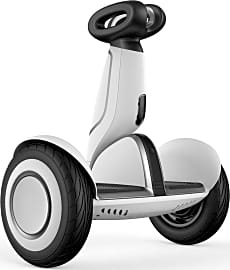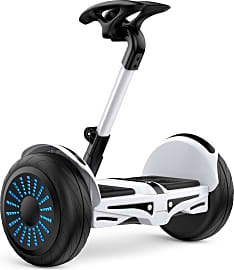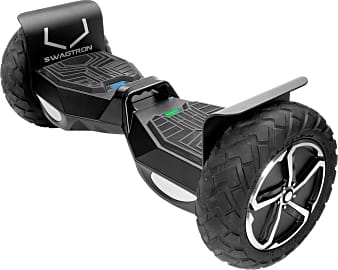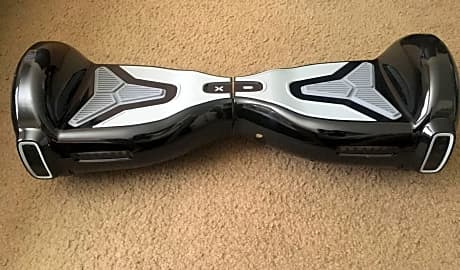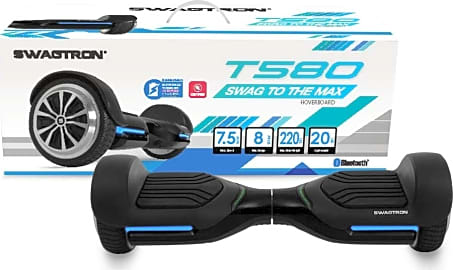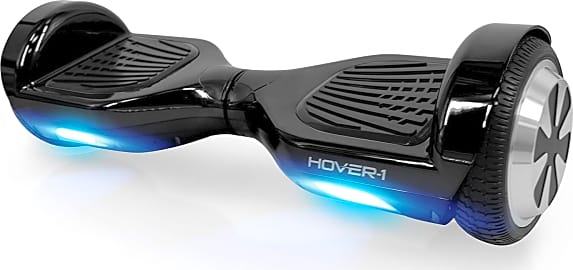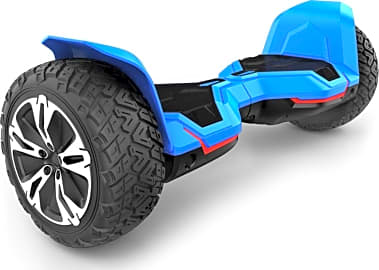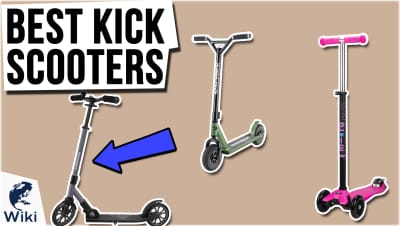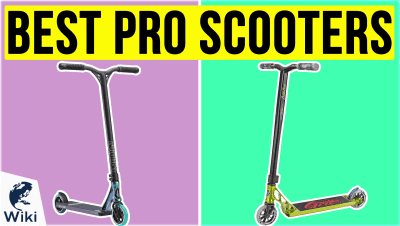The 10 Best Self Balancing Scooters

This wiki has been updated 38 times since it was first published in August of 2015. Whether they are just for fun or for serious commuting between school, work, and home (or the nearest public transit station), personal transport devices, which include hoverboards, self-balancing scooters, drifting boards, and handless Segways, offer a fun, environmentally-friendly, alternative means of getting around that may also help improve your core strength and coordination. When users buy our independently chosen editorial recommendations, we may earn commissions to help fund the Wiki.
Editor's Notes
April 29, 2021:
Searching for the right self-balancing scooter, or hoverboard, as they are more commonly known, is far easier now that a number of safety issues and initial teething troubles have been addressed. The biggest problem encountered was their susceptibility to short-circuiting and catching fire while charging, and now they undergo strict testing prior to release, in order to meet new stringent safety standards, and many, including the Hover-1 Ultra listed here, are fitted with battery shields to offer an extra layer of protection against combustion.
Other issues that have been addressed include audible alarms that notify the user when the battery is running low. This is to counter problems faced when people are pitched forward, as certain models are known to stop very abruptly following a loss of power. Once the alarm sounds, it is best to stop immediately and carry your scooter to the nearest outlet for charging.
Our latest update includes two new models, starting with the Maxfree Smart, which is similar to the popular Segway Ninebot S-Plus, in that it incorporates a central steering column, that aids stability while making it easier to make precise and tight turns. One way it significantly differs from the Segway is on price, as this is a far more affordable option, which retains many of the same features as its pricier counterpart.
We also liked the aforementioned Hover-1 Ultra, as it is a good all-rounder that has an impressive range, a short charging time of around four hours, and is nippy enough when used on smoother surfaces. It does, however, feature thinner tires, which can wear quicker when supporting heavier loads or when used on rougher terrain. This model also features particularly powerful LED lamps, which make the user more visible to pedestrians and traffic, and also effectively light up the road ahead when used in low light conditions.
March 19, 2020:
For a while now, one of the biggest concerns for most people when buying a self-balancing scooter is the risk of it catching fire during charging. While this used to be a valid concern, these days, most models available in the market, and every one on this list, are all UL certified to ensure they meet all necessary safety standards. That being said, it is still important to follow the manufacturer's guidelines regarding charging times.
When combing through our recommendations on our previous list, we had to eliminate a number of models for various reasons. For example, the Hovertrax 2.0 has numerous complaints of randomly stopping without warning, which can be dangerous, and the MegaWheels Hoverboard tends to suffer from charging issues, even after minimal use.
If you are looking for a model to commute to and from work, the Segway Ninebot S-Plus is probably the best option with its impressive 22-mile range. It also offers a 12.5-mile maximum speed and has large, air-filled tires that easily handle bumps and cracks on the pavement. Though if you are really looking for a commuter option, you may be better off with one of the models on our list of the best long-range scooters even if they aren't self balancing. Getting back to the topic of bumps and cracks, we also included a few models that are well-suited to off-road use, such as the Swagtron T6 and Gyroor Warrior G2, both of which have deep tread, large tires, and the ability to handle steep inclines. While not specifically designed as off-road models, the Epikgo Sport and Hover-1 Titan also perform rather well on a variety of terrains.
When it comes to looks, few models can match the sleek, sporty design of the Gyroor G-F1 2.0, however some units do suffer from longevity issues, so it is worth keeping that in mind. The IotaTrax Scooter is another model that really has a stand-out design. It looks more akin to self-balancing unicycles than a traditional hoverboard. Plus, it weighs a mere 15 pounds and folds up very compactly.
Special Honors
Ninebot One S1 This self-balancing unicycle can travel at speeds upwards of 12.5 miles per hour and offers a 15-mile range. A 220-pound weight limit allows it to accommodate most riders and it features a built-in carrying handle, though at 25 pounds that may be difficult for some to do for any length of time. store.segway.com
Halo Rover X The Halo Rover X offers three modes: beginner, normal, and advanced, allowing you to match it to your skill level. Two 400-watt motors help it tackle steep inclines, while its rugged tires make it suitable for a variety of terrains. It comes with access to an associated app that allows you to control and customize various ride and aesthetic features. haloboard.com
InMotion V8 With a 30-mile range and a 19-MPH top speed, the InMotion V8 is a good choice for commuters or anyone else expects to go far without access to a charging port. Thanks to its single-wheel design, it boasts a very tight turning radius, too. myinmotion.com
Simplify Your Commute
Placing your feet on the pressure pads allows for control of the device.
Commuting choices are personal and greatly depend on how you feel, how far you have to travel, what the weather is like, and how easy the streets are to traverse. Bicycles are reliable, but require physical energy which can be tolling if your commute is lengthy. Cars are environmentally hazardous, nor are they the healthiest form of commuting on a daily basis.
A more cost-effective, eco-friendly, and easy-to-use alternative is the self-balancing scooter. We're not talking about futuristic hoverboards as seen in Back to the Future Part Two, as the term is sometimes used to describe the similar concept.
Technically speaking, balance scooters are portable and rechargeable battery-powered, featuring two side-by-side wheels. Placing your feet on the pressure pads allows for control of the device. Some only have one wheel instead, with two pressure pads on either side. The main components of a self-balancing scooter (with two wheels) include a central processing unit (CPU), battery pack, two gyroscopes, infrared sensors, LED lights, two electric motors, two tilt and speed sensors, a charging port, and pressure pads that sit on switches.
Think of the CPU as the brain that interprets the overall status of the scooter, its current speed, and the tilt of each wheel. The tilt and speed sensors detect wheel revolutions per minute (RPM) and are housed inside the wheels along with the electric motors. The sensors are controlled by a combination of a person's feet, the shifting of weight on the scooter's pressure pads, and the interruption of the scooter's LED lights.
To accelerate, a rider leans forward on the scooter with both feet. The more a rider leans forward, the faster the scooter goes. This occurs because the tilt sensors and gyroscopes are interpreting the motion of leaning forward as a command to increase the scooter's speed. By increasing speed in this manner, a rider's center of gravity is maintained, much in the same way the inner ear maintains a person's sense of balance.
The infrared LED lights (located on the underside of the scooter) act as command markers for each sensor. When forward pressure is applied to the front of both pads, the scooter's front switches (located underneath each pad) are also pushed down. The depression of each switch causes a small plastic barrier to slide in-between each infrared LED and its corresponding sensor, thereby interrupting the LED light. When the senors detect this interruption, the CPU instructs the appropriate motors to spin forward.
To slow down, stop, or move in reverse, the rider simply leans backward and applies pressure to the back of the pads (activating the rear switches) with their heels. Turning left or right is accomplished by operating the pressure pads with either a forward or backward tilt. To turn left, for example, a rider applies pressure with the front of their right foot and the heel of their left foot. This instructs the scooter to spin the right wheel forward and the left wheel in reverse. The wheel spinning in reverse influences the direction of the turn.
Because it is powered by a rechargeable battery, operation is quiet with virtually no harmful emissions released into the environment. It also saves you a small fortune in filling up your gas tank, and is much lighter and transportable too.
Self-Balancing Scooter History, Hitches, And Hope
The overall consensus credits the Chinese manufacturing industry with the origin of the self-balancing scooter. Due to the fast pace of the industry, it can be difficult to pinpoint exactly which Chinese manufacturer got there first. It is thought that Chic Robotics (also known as Hangzhou Chic Intelligent Technology Co., Ltd) was the first to invent the self-balancing scooter. The company was originally founded in 2013 and is associated with the prestigious Zhejiang University. The company released a scooter named the Smart S1 in August 2014.
The following year, the market saw numerous Chinese knockoff scooters, where monetary greed outweighed safety necessitation. This developed into inevitable problems, particularly with some models of scooters catching fire. Incidents in locations like New York and Louisiana prompted a recall of over a half-million self-balancing scooters by the United States Consumer Product Safety Commission in July 2016.
Some companies, such as IO Hawk, have been working on scooters that offer WiFi connections and extended battery life.
But don't click away just yet. While these incidents were serious, it's important to understand what prompted such defects in the first place. In 2015, the self-balancing scooter was on a lot of Christmas lists as the newest and hottest accessory that so many people wanted under the tree. This was true for both celebrities and civilians. Due to such a high demand over the 2015 holiday season, various Chinese manufacturers began mass production of the scooter using low quality materials in the hopes of attracting everyday buyers with more affordable prices.
It's not an uncommon occurrence for production to be cheapened in the face of high demand in order to keep up with it. For that reason, one cannot single out Chinese manufacturers as the only ones who do this. Mass production and franchising often leads to a watering down of a product's quality in order hit one's financial bottom line for profits. It so happens that for the self-balancing scooter, the main culprit behind many of the 2015 defects and recalls were the lithium-ion batteries used.
Many of the batteries were located under a scooter's pressure pads. Fires were prone to occur, regardless of whether the scooters were plugged in and charging or not. With low-quality batteries, bumping into things with a scooter could become significantly more dangerous. Additionally, the separator between a cheap battery's cathode and anode, both of which conduct the electrical current, could be misaligned. In this situation, short circuits were more likely to occur due to increasing heat inside the battery cell.
Contrary to how depressing this problem may appear, there is light at the end of the tunnel, thanks to the Underwriter Laboratories UL2272 safety standard that was introduced in early 2016. This standard requires the self-balancing scooter to undergo a rigorous testing process during which the electrical, battery, and charger systems are certified. This certification would provide additional confidence to consumers that their purchase was a smart and safe investment.
Some of the newest models of scooter come equipped with built-in Bluetooth speakers and additional lights. Recent popularity of the scooter in the United States is attributed to the celebrity factor and the American-found company PhunkeeTree, which began distributing self-balancing scooters after its co-founders were introduced to the scooter at the 2014 Hong Kong Electronics Show.
So what's in store for the self-balancing scooter of the future? Some companies, such as IO Hawk, have been working on scooters that offer WiFi connections and extended battery life. For the busy commuter, staying connected and traveling a greater distance without having to recharge are welcome advantages. Even Lexus is currently working on its own form of magnetized hoverboard technology with the use of liquid nitrogen-filled cryostat that cools the board's superconductors. While it's not quite ready for Marty McFly's epic hoverboard chases from Back to The Future Two, it certainly looks like a step in the right direction.
Taking It Slow
Battery life, top speed, and charging time are all important considerations for the scooter one chooses. Superior models deliver a top speed of up to ten miles per hour with a traveling distance of up to fourteen miles on a single charge. For newcomers, setting aside time to adapt to the way the scooter operates is important.
Superior models deliver a top speed of up to ten miles per hour with a traveling distance of up to fourteen miles on a single charge.
This can be done using a wall for leverage when learning how to balance on the scooter. A beginner's mode is sometimes built into the design of the scooter to limit its speed at first. Some scooters also come equipped with steering bars for extra control and comfort, particularly when traveling on busy streets.
Consider the style of the scooter you want. It comes in a multitude of different brands and colors, so finding one that speaks to you and your personal preferences will make all the difference when you plan to ride it all the time. Some of the best self-balancing scooters also have sturdy pneumatic tires with shock absorption capabilities.
When it comes to self balancing scooters, safety and reliability are of the utmost concern. If you can find a scooter that is certified by Underwriter Laboratories (UL),the American safety consulting and certification company, you're taking a step in the right direction. A UL-certified battery means it has been tested, inspected, and validated to meet safety requirements, and is particularly important for extra peace of mind.



